Eppendorf 5427 R User Manual [en, es]
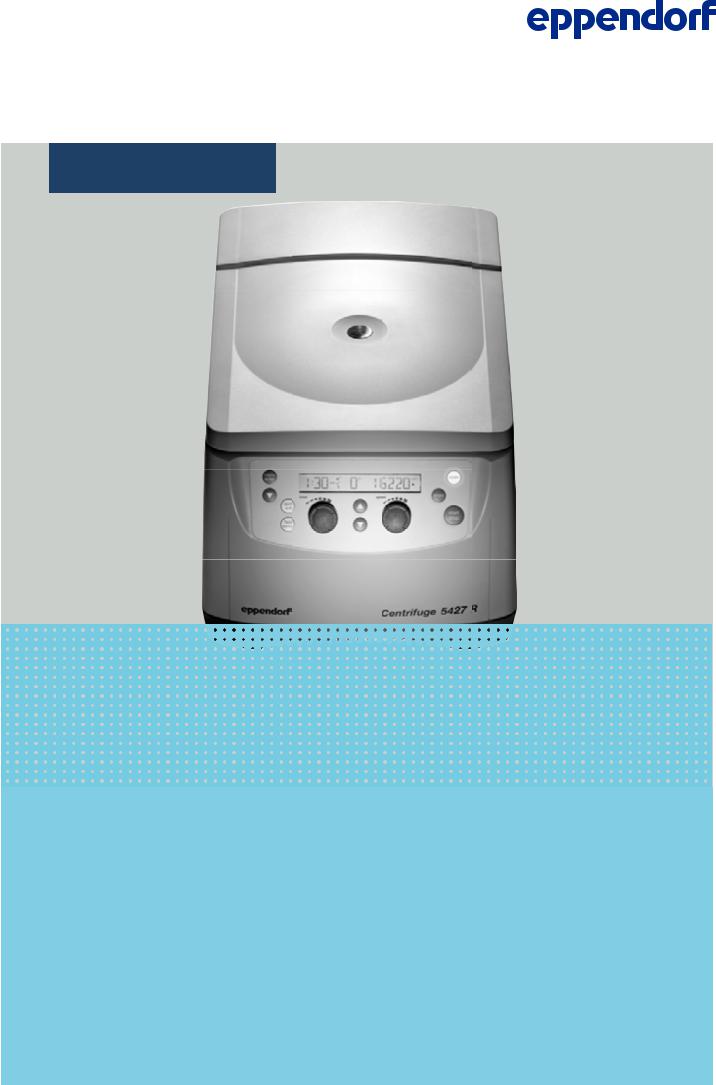
Register your instrument!
www.eppendorf.com/myeppendorf
Centrifuge 5427 R
Operating manual
Manual de instrucciones
Copyright © 2013 Eppendorf AG, Hamburg. No part of this publication may be reproduced without the prior permission of the copyright owner.
Trademarks
Eppendorf and the Eppendorf logo are registered trademarks of Eppendorf AG, Hamburg, Germany. Microtainer is a registered trademark of Becton Dickinson, Franklin Lakes, NJ, USA.
Trademarks are not marked in all cases with ™ or ® in this manual.
Operating manual. . . . . . . . . . . . . . . . . . . . . . . . . . . . . . . . . . . . . . . . . . . . . . . . . . . . . . . . . . . . . . . . . . . . . . 3 Manual de instrucciones . . . . . . . . . . . . . . . . . . . . . . . . . . . . . . . . . . . . . . . . . . . . . . . . . . . . . . . . . . . . . . . 55 Declarations and Certificates . . . . . . . . . . . . . . . . . . . . . . . . . . . . . . . . . . . . . . . . . . . . . . . . . . . . . . . . . . . . 95
5409 900.021-02/072013

Table of contents
Centrifuge 5427 R 3
English (EN)
Table of contents
1 Operating instructions . . . . . . . . . . . . . . . . . . . . . . . . . . . . . . . . . . . . . . . . . . . . . . . . . . . . . . . . . . . . . . 5
1.1 Using this manual . . . . . . . . . . . . . . . . . . . . . . . . . . . . . . . . . . . . . . . . . . . . . . . . . . . . . . . . . . . . . 5 1.2 Danger symbols and danger levels . . . . . . . . . . . . . . . . . . . . . . . . . . . . . . . . . . . . . . . . . . . . . . . . 5 1.2.1 Danger symbols . . . . . . . . . . . . . . . . . . . . . . . . . . . . . . . . . . . . . . . . . . . . . . . . . . . . . . . 5 1.2.2 Danger levels. . . . . . . . . . . . . . . . . . . . . . . . . . . . . . . . . . . . . . . . . . . . . . . . . . . . . . . . . . 5
1.3 Symbols used . . . . . . . . . . . . . . . . . . . . . . . . . . . . . . . . . . . . . . . . . . . . . . . . . . . . . . . . . . . . . . . . 5 1.4 Abbreviations used . . . . . . . . . . . . . . . . . . . . . . . . . . . . . . . . . . . . . . . . . . . . . . . . . . . . . . . . . . . . 6
2 Product description . . . . . . . . . . . . . . . . . . . . . . . . . . . . . . . . . . . . . . . . . . . . . . . . . . . . . . . . . . . . . . . . 7
2.1 Main illustration . . . . . . . . . . . . . . . . . . . . . . . . . . . . . . . . . . . . . . . . . . . . . . . . . . . . . . . . . . . . . . 7 2.2 Delivery package. . . . . . . . . . . . . . . . . . . . . . . . . . . . . . . . . . . . . . . . . . . . . . . . . . . . . . . . . . . . . . 8 2.3 Features. . . . . . . . . . . . . . . . . . . . . . . . . . . . . . . . . . . . . . . . . . . . . . . . . . . . . . . . . . . . . . . . . . . . . 8 2.4 Rotors . . . . . . . . . . . . . . . . . . . . . . . . . . . . . . . . . . . . . . . . . . . . . . . . . . . . . . . . . . . . . . . . . . . . . . 9 2.4.1 Rotor FA-45-12-17. . . . . . . . . . . . . . . . . . . . . . . . . . . . . . . . . . . . . . . . . . . . . . . . . . . . . . 9 2.4.2 Rotor FA-45-24-11. . . . . . . . . . . . . . . . . . . . . . . . . . . . . . . . . . . . . . . . . . . . . . . . . . . . . 10 2.4.3 Rotor FA-45-24-11-Kit. . . . . . . . . . . . . . . . . . . . . . . . . . . . . . . . . . . . . . . . . . . . . . . . . . 11 2.4.4 Rotors FA-45-30-11 and F-45-30-11 . . . . . . . . . . . . . . . . . . . . . . . . . . . . . . . . . . . . . . . 12 2.4.5 Rotors FA-45-48-11 and F-45-48-11 . . . . . . . . . . . . . . . . . . . . . . . . . . . . . . . . . . . . . . . 13 2.4.6 Rotor F-45-48-5-PCR. . . . . . . . . . . . . . . . . . . . . . . . . . . . . . . . . . . . . . . . . . . . . . . . . . . 14 2.4.7 Rotor S-24-11-AT . . . . . . . . . . . . . . . . . . . . . . . . . . . . . . . . . . . . . . . . . . . . . . . . . . . . . 14
3 Safety. . . . . . . . . . . . . . . . . . . . . . . . . . . . . . . . . . . . . . . . . . . . . . . . . . . . . . . . . . . . . . . . . . . . . . . . . . . 15
3.1 Intended use . . . . . . . . . . . . . . . . . . . . . . . . . . . . . . . . . . . . . . . . . . . . . . . . . . . . . . . . . . . . . . . . 15 3.2 User profile . . . . . . . . . . . . . . . . . . . . . . . . . . . . . . . . . . . . . . . . . . . . . . . . . . . . . . . . . . . . . . . . . 15 3.3 Application limits . . . . . . . . . . . . . . . . . . . . . . . . . . . . . . . . . . . . . . . . . . . . . . . . . . . . . . . . . . . . 15 3.3.1 Declaration concerning the ATEX directive (94/9/EC) . . . . . . . . . . . . . . . . . . . . . . . . . 15 3.3.2 Maximum service life for accessories. . . . . . . . . . . . . . . . . . . . . . . . . . . . . . . . . . . . . . 15
3.4 Information on product liability . . . . . . . . . . . . . . . . . . . . . . . . . . . . . . . . . . . . . . . . . . . . . . . . . 16 3.5 Warnings for intended use . . . . . . . . . . . . . . . . . . . . . . . . . . . . . . . . . . . . . . . . . . . . . . . . . . . . . 17 3.5.1 Personal injury or damage to the equipment . . . . . . . . . . . . . . . . . . . . . . . . . . . . . . . . 17 3.5.2 Incorrect handling of the centrifuge . . . . . . . . . . . . . . . . . . . . . . . . . . . . . . . . . . . . . . . 18 3.5.3 Incorrect handling of the rotors . . . . . . . . . . . . . . . . . . . . . . . . . . . . . . . . . . . . . . . . . . 18 3.5.4 Extreme strain on the centrifuging tubes . . . . . . . . . . . . . . . . . . . . . . . . . . . . . . . . . . . 19 3.5.5 Aerosol-tight centrifugation . . . . . . . . . . . . . . . . . . . . . . . . . . . . . . . . . . . . . . . . . . . . . 20
3.6 Safety instructions located on the device . . . . . . . . . . . . . . . . . . . . . . . . . . . . . . . . . . . . . . . . . . 20
4 Installation . . . . . . . . . . . . . . . . . . . . . . . . . . . . . . . . . . . . . . . . . . . . . . . . . . . . . . . . . . . . . . . . . . . . . . 21
4.1 Selecting the location . . . . . . . . . . . . . . . . . . . . . . . . . . . . . . . . . . . . . . . . . . . . . . . . . . . . . . . . . 21 4.2 Preparing installation . . . . . . . . . . . . . . . . . . . . . . . . . . . . . . . . . . . . . . . . . . . . . . . . . . . . . . . . . 21 4.3 Installing the instrument. . . . . . . . . . . . . . . . . . . . . . . . . . . . . . . . . . . . . . . . . . . . . . . . . . . . . . . 22
5 Operation . . . . . . . . . . . . . . . . . . . . . . . . . . . . . . . . . . . . . . . . . . . . . . . . . . . . . . . . . . . . . . . . . . . . . . . 23
5.1 Overview of operating controls . . . . . . . . . . . . . . . . . . . . . . . . . . . . . . . . . . . . . . . . . . . . . . . . . . 23 5.2 Menu navigation . . . . . . . . . . . . . . . . . . . . . . . . . . . . . . . . . . . . . . . . . . . . . . . . . . . . . . . . . . . . . 25 5.3 Menu . . . . . . . . . . . . . . . . . . . . . . . . . . . . . . . . . . . . . . . . . . . . . . . . . . . . . . . . . . . . . . . . . . . . . . 25 5.4 Preparing for centrifugation . . . . . . . . . . . . . . . . . . . . . . . . . . . . . . . . . . . . . . . . . . . . . . . . . . . . 27 5.4.1 Switching on the centrifuge . . . . . . . . . . . . . . . . . . . . . . . . . . . . . . . . . . . . . . . . . . . . . 27 5.4.2 Inserting the rotor . . . . . . . . . . . . . . . . . . . . . . . . . . . . . . . . . . . . . . . . . . . . . . . . . . . . . 27 5.4.3 Automatic rotor detection . . . . . . . . . . . . . . . . . . . . . . . . . . . . . . . . . . . . . . . . . . . . . . . 27 5.4.4 Replacing the rotor . . . . . . . . . . . . . . . . . . . . . . . . . . . . . . . . . . . . . . . . . . . . . . . . . . . . 27 5.4.5 Loading the rotor . . . . . . . . . . . . . . . . . . . . . . . . . . . . . . . . . . . . . . . . . . . . . . . . . . . . . 28 5.4.6 Closing the rotor lid . . . . . . . . . . . . . . . . . . . . . . . . . . . . . . . . . . . . . . . . . . . . . . . . . . . 30 5.4.7 Closing the centrifuge lid . . . . . . . . . . . . . . . . . . . . . . . . . . . . . . . . . . . . . . . . . . . . . . . 30

Table of contents
4Centrifuge 5427 R English (EN)
5.5 Cooling . . . . . . . . . . . . . . . . . . . . . . . . . . . . . . . . . . . . . . . . . . . . . . . . . . . . . . . . . . . . . . . . . . . . 30 5.5.1 Set the temperature. . . . . . . . . . . . . . . . . . . . . . . . . . . . . . . . . . . . . . . . . . . . . . . . . . . . 30 5.5.2 Temperature display . . . . . . . . . . . . . . . . . . . . . . . . . . . . . . . . . . . . . . . . . . . . . . . . . . . 30 5.5.3 Temperature monitoring . . . . . . . . . . . . . . . . . . . . . . . . . . . . . . . . . . . . . . . . . . . . . . . . 31 5.5.4 Start FastTemp . . . . . . . . . . . . . . . . . . . . . . . . . . . . . . . . . . . . . . . . . . . . . . . . . . . . . . . 31 5.5.5 Continuous cooling . . . . . . . . . . . . . . . . . . . . . . . . . . . . . . . . . . . . . . . . . . . . . . . . . . . . 32 5.5.6 Endless operation of continuous cooling . . . . . . . . . . . . . . . . . . . . . . . . . . . . . . . . . . . 32
5.6 Centrifuging . . . . . . . . . . . . . . . . . . . . . . . . . . . . . . . . . . . . . . . . . . . . . . . . . . . . . . . . . . . . . . . . 33 5.6.1 Centrifuging with preset time . . . . . . . . . . . . . . . . . . . . . . . . . . . . . . . . . . . . . . . . . . . . 33 5.6.2 Centrifuging in continuous operation . . . . . . . . . . . . . . . . . . . . . . . . . . . . . . . . . . . . . . 34 5.6.3 Short spin centrifugation . . . . . . . . . . . . . . . . . . . . . . . . . . . . . . . . . . . . . . . . . . . . . . . 34 5.6.4 Setting the centrifugation radius . . . . . . . . . . . . . . . . . . . . . . . . . . . . . . . . . . . . . . . . . 35 5.6.5 After centrifugation. . . . . . . . . . . . . . . . . . . . . . . . . . . . . . . . . . . . . . . . . . . . . . . . . . . . 35
5.7 Standby mode . . . . . . . . . . . . . . . . . . . . . . . . . . . . . . . . . . . . . . . . . . . . . . . . . . . . . . . . . . . . . . . 35
6 Maintenance . . . . . . . . . . . . . . . . . . . . . . . . . . . . . . . . . . . . . . . . . . . . . . . . . . . . . . . . . . . . . . . . . . . . . 37
6.1 Prepare cleaning/disinfection . . . . . . . . . . . . . . . . . . . . . . . . . . . . . . . . . . . . . . . . . . . . . . . . . . . 37 6.2 Cleaning/disinfection . . . . . . . . . . . . . . . . . . . . . . . . . . . . . . . . . . . . . . . . . . . . . . . . . . . . . . . . . 37 6.2.1 Cleaning and disinfecting the device . . . . . . . . . . . . . . . . . . . . . . . . . . . . . . . . . . . . . . 38 6.2.2 Cleaning and disinfecting the rotor . . . . . . . . . . . . . . . . . . . . . . . . . . . . . . . . . . . . . . . 38
6.3 Additional service instructions for Centrifuge 5427 R . . . . . . . . . . . . . . . . . . . . . . . . . . . . . . . . 39 6.4 Glass breakage . . . . . . . . . . . . . . . . . . . . . . . . . . . . . . . . . . . . . . . . . . . . . . . . . . . . . . . . . . . . . . 39 6.5 Replacing fuses . . . . . . . . . . . . . . . . . . . . . . . . . . . . . . . . . . . . . . . . . . . . . . . . . . . . . . . . . . . . . . 40 6.6 Decontamination before shipment . . . . . . . . . . . . . . . . . . . . . . . . . . . . . . . . . . . . . . . . . . . . . . . 40
7 Troubleshooting . . . . . . . . . . . . . . . . . . . . . . . . . . . . . . . . . . . . . . . . . . . . . . . . . . . . . . . . . . . . . . . . . . 41
7.1 General errors . . . . . . . . . . . . . . . . . . . . . . . . . . . . . . . . . . . . . . . . . . . . . . . . . . . . . . . . . . . . . . . 41 7.2 Error messages . . . . . . . . . . . . . . . . . . . . . . . . . . . . . . . . . . . . . . . . . . . . . . . . . . . . . . . . . . . . . . 42 7.3 Emergency release . . . . . . . . . . . . . . . . . . . . . . . . . . . . . . . . . . . . . . . . . . . . . . . . . . . . . . . . . . . 44
8 Transport, storage and disposal . . . . . . . . . . . . . . . . . . . . . . . . . . . . . . . . . . . . . . . . . . . . . . . . . . . . . 45
8.1 Transport . . . . . . . . . . . . . . . . . . . . . . . . . . . . . . . . . . . . . . . . . . . . . . . . . . . . . . . . . . . . . . . . . . . 45 8.2 Storage . . . . . . . . . . . . . . . . . . . . . . . . . . . . . . . . . . . . . . . . . . . . . . . . . . . . . . . . . . . . . . . . . . . . 45 8.3 Disposal. . . . . . . . . . . . . . . . . . . . . . . . . . . . . . . . . . . . . . . . . . . . . . . . . . . . . . . . . . . . . . . . . . . . 45
9 Technical data. . . . . . . . . . . . . . . . . . . . . . . . . . . . . . . . . . . . . . . . . . . . . . . . . . . . . . . . . . . . . . . . . . . . 47
9.1 Power supply. . . . . . . . . . . . . . . . . . . . . . . . . . . . . . . . . . . . . . . . . . . . . . . . . . . . . . . . . . . . . . . . 47 9.2 Ambient conditions . . . . . . . . . . . . . . . . . . . . . . . . . . . . . . . . . . . . . . . . . . . . . . . . . . . . . . . . . . . 47 9.3 Weight/dimensions . . . . . . . . . . . . . . . . . . . . . . . . . . . . . . . . . . . . . . . . . . . . . . . . . . . . . . . . . . . 47 9.4 Application parameters . . . . . . . . . . . . . . . . . . . . . . . . . . . . . . . . . . . . . . . . . . . . . . . . . . . . . . . . 48
9.5Acceleration times and deceleration times for the Centrifuge 5427 R (according to DIN 58 970)
49
10 Ordering Information . . . . . . . . . . . . . . . . . . . . . . . . . . . . . . . . . . . . . . . . . . . . . . . . . . . . . . . . . . . . . . 51
10.1 Centrifuge 5427 R . . . . . . . . . . . . . . . . . . . . . . . . . . . . . . . . . . . . . . . . . . . . . . . . . . . . . . . . . . . . 51 10.2 Accessories . . . . . . . . . . . . . . . . . . . . . . . . . . . . . . . . . . . . . . . . . . . . . . . . . . . . . . . . . . . . . . . . . 51 10.2.1 Rotors and rotor lids . . . . . . . . . . . . . . . . . . . . . . . . . . . . . . . . . . . . . . . . . . . . . . . . . . . 51 10.2.2 Adapters . . . . . . . . . . . . . . . . . . . . . . . . . . . . . . . . . . . . . . . . . . . . . . . . . . . . . . . . . . . . 52 10.2.3 Other accessories . . . . . . . . . . . . . . . . . . . . . . . . . . . . . . . . . . . . . . . . . . . . . . . . . . . . . 53 10.3 Safety. . . . . . . . . . . . . . . . . . . . . . . . . . . . . . . . . . . . . . . . . . . . . . . . . . . . . . . . . . . . . . . . . . . . . . 53

Operating instructions
Centrifuge 5427 R 5
English (EN)
1Operating instructions
1.1Using this manual
Read this operating manual completely before using the device for the first time. Please also note the operating instructions for the accessories, if applicable.
This operating manual is part of the product. Thus, it must always be easily accessible.
Enclose this operating manual when transferring the device to third parties.
If this manual is lost, please request another one. You will find the current version on our webpage www.eppendorf.com.
1.2Danger symbols and danger levels
The safety instructions in this manual appear with the following danger symbols and danger levels:
1.2.1Danger symbols
Biohazard |
Explosion |
Electric shock |
Crushing |
Hazard point |
Material damage |
1.2.2Danger levels
DANGER |
Will lead to severe injuries or death. |
|
|
WARNING |
Can lead to severe injuries or death. |
|
|
CAUTION |
Can lead to light to moderate injuries. |
|
|
ATTENTION |
May lead to material damage./Paragraph |
|
|
1.3Symbols used
Depiction |
Meaning |
||
|
|
|
|
1. |
|
Actions in the specified order |
|
2. |
|
|
|
|
|
|
|
|
Actions without a specified order |
||
|
|
|
|
• |
List: |
||
|
|
|
|
Text |
Display or software texts |
||
|
|
|
|
|
|
|
Additional information |
|
|
|
|
|
|
|
|
|
|
|
|

Operating instructions
6Centrifuge 5427 R English (EN)
1.4Abbreviations used
NN
Mean sea level (MSL)
PCR
Polymerase chain reaction
RZB/rcf
Relative centrifugal force – g-force in m/s2
rpm
Revolutions per minute – in rpm
UV
Ultraviolet radiation
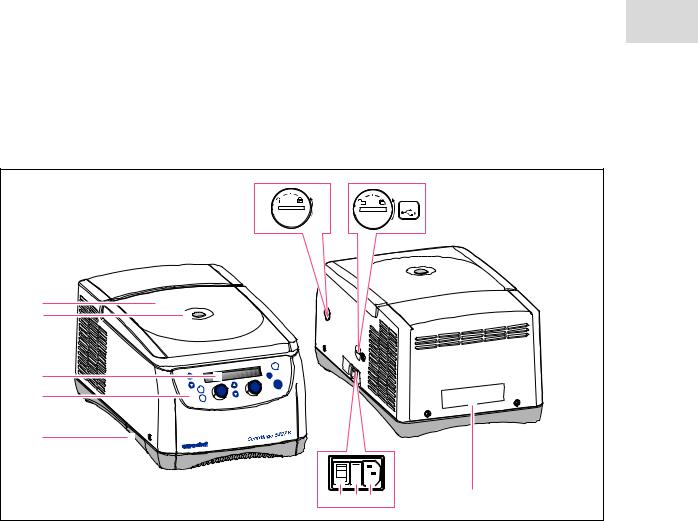
Product description
Centrifuge 5427 R 7
English (EN)
2Product description
2.1Main illustration
|
|
|
|
USB |
|
6 |
|
|
7 |
1 |
|
|
|
|
2 |
|
|
|
|
|
|
open |
|
|
3 |
menu |
short |
|
|
enter |
|
|
|
|
|
start |
|
|
|
|
|
stop |
|
|
4 |
rpm |
|
|
|
rcf |
|
|
|
|
fast |
|
|
|
|
temp |
|
|
|
|
|
|
|
|
|
5 |
|
|
|
|
|
|
8 |
9 10 |
11 |
Fig. 2-1: Front and rear view of the Centrifuge 5427 R
1 |
Centrifuge lid |
7 |
USB port |
2 |
Monitoring glass |
|
Only for Technical Service: interfaces for error |
|
analyses and software updates |
||
|
Visual control for rotor stop or speed control |
|
|
|
|
|
|
|
option using stroboscope |
8 |
Mains/power switch |
3 |
Display |
|
Switch for switching the device on (I) and off (0) |
|
|
||
|
Display of centrifugation parameters and device |
9 |
Fuse holder |
|
settings (see Fig. 5-2 on p. 24) |
10 |
Power connection socket |
|
|
||
4 |
Control panel |
|
Connection for supplied power cable |
|
Keys and dials for operating centrifuge (see |
11 |
Name plate |
|
Fig. 5-1 on p. 23) |
||
|
|
|
5 Condensation water tray (only)
6Emergency release
(see p. 44)

Product description
8Centrifuge 5427 R English (EN)
2.2 Delivery package
Quant |
Order no. |
Order no. |
Description |
ity |
(International) |
(North America) |
|
|
|
|
|
|
|
|
Centrifuge 5427 R |
1 |
- |
- |
See chapter Ordering Information for corresponding device |
|
|
|
version, equipment and order number |
|
|
|
|
|
|
|
Fuse |
1 |
5301 850.249 |
022654403 |
4.0 A (230 V), 2 pieces |
or |
5427 850.341 |
022654381 |
8.0 AT UL (120 V/100 V), 2 pieces |
or |
5811 352.006 |
022664107 |
10.0 AT UL (100 V), 2 pieces |
|
|
|
|
|
|
|
Rotor key |
1 |
5416 301.001 |
022634305 |
Standard |
|
|
|
|
1 |
- |
- |
Mains power cable |
1 |
5409 850.083 |
|
Tray for condensation water |
|
|
|
Operating Manual Centrifuge 5427 R |
1 |
5409 900.021 |
5409900021 |
Languages: EN, DE, FR, ES, IT, PT |
1 |
5409 900.030 |
5409900030 |
Languages: DA, FI, EL, NL, SV (only 230 V devices) |
|
|
|
|
2.3Features
The high-performance Centrifuge 5427 R has a capacity of 48 × 2 mL and maximally reaches 25 001 × g resp. maximally 16 220 rpm. You can select from 9 different rotors to centrifuge the following tubes for your various applications:
•Tubes (0.2 mL to 5.0 mL)
•PCR strips
•Microtainers (0.6 ml)
•Spin columns (1.5 mL, 2.0 mL)
The Centrifuge 5427 R has a temperature function for centrifugation at temperatures of-11 °C to 40 °C. The FastTemp function is used to start a temperature control run without samples in order to quickly bring the rotor chamber to the set temperature.
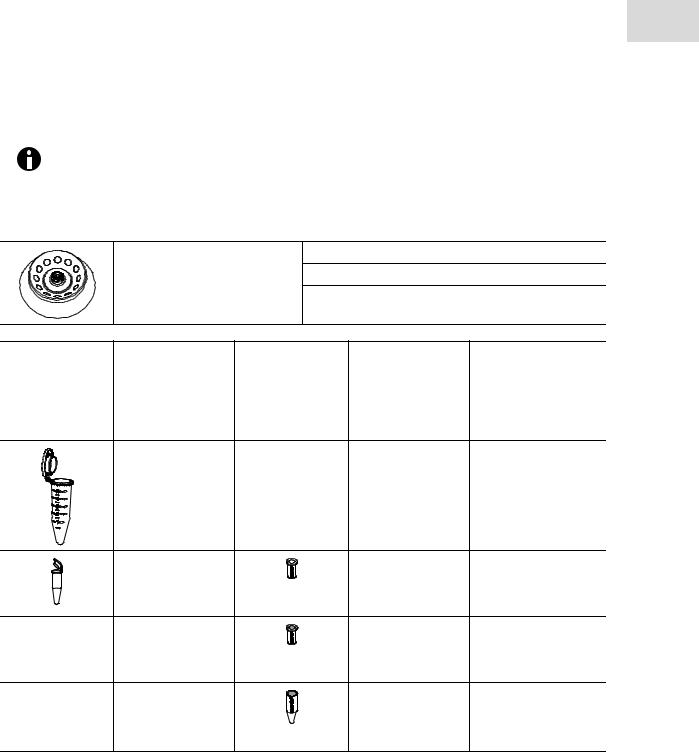
Product description
Centrifuge 5427 R 9
English (EN)
2.4Rotors
Eppendorf centrifuges may only be operated with rotors that are intended for use with the corresponding centrifuge.
Only use rotors which are marked with the name of the centrifuge (e.g., 5427 R).
2.4.1Rotor FA-45-12-17
|
Rotor FA-45-12-17 |
Max. g-force: |
20 598 × g |
|
|
Max. speed: |
14 000 rpm |
||
|
|
|||
|
Aerosol-tight fixed-angle rotor |
|
|
|
|
for 12 reaction tubes |
Max. load (adapter, tube |
12 × 9.5 g |
|
|
|
and contents): |
|
|
Vessels |
Vessel |
Adapters |
Adapter base |
Max. g-force: |
|
Capacity |
Order no. |
Tube diameter |
Max. speed |
|
|
(international) |
|
|
|
Vessels per |
|
|
Centrifugation radius |
|
adapter/rotor |
|
|
|
|
Vessel |
– |
– |
20 598 × g |
|
5 mL |
|
Ø 17 mm |
14 000 rpm |
|
-/12 |
|
|
9.4 cm |
Vessel |
open |
17 530 × g |
1.5 mL/2.0 mL |
Ø 11 mm |
14 000 rpm |
1/12 |
5820 768.002 |
8.0 cm |
|
||
HPLC vessel |
flat |
16 215 × g |
|
Ø 11 mm |
14 000 rpm |
1/12 |
5820 770.007 |
7.4 cm |
|
||
Cryo tube |
flat |
18 188 × g |
1.0 mL – 2.0 mL |
Ø 13 mm |
14 000 rpm |
1/12 |
5820 769.009 |
8.3 cm |
|
|
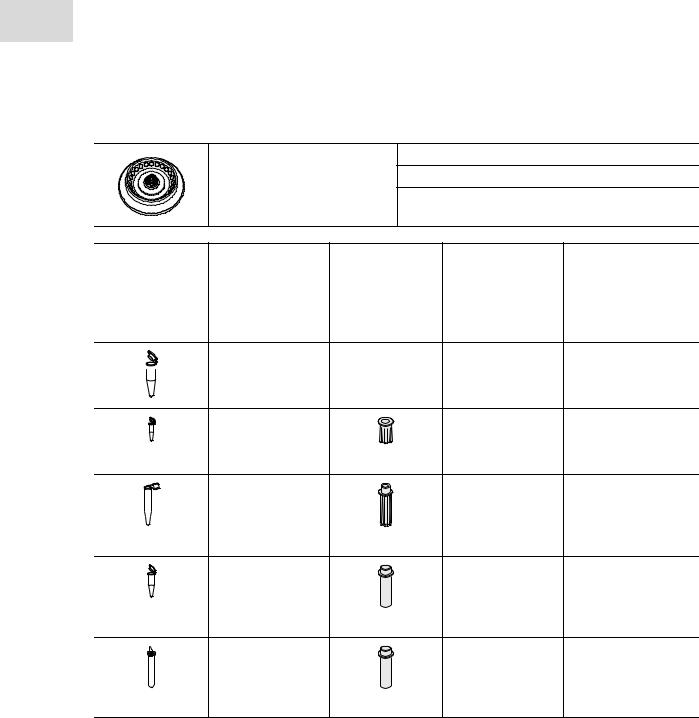
Product description
10Centrifuge 5427 R English (EN)
2.4.2 Rotor FA-45-24-11
|
Rotor FA-45-24-11 |
Max. g-force: |
25 001 × g |
|
|
Max. speed: |
16 220 rpm |
||
|
|
|||
|
Aerosol-tight fixed-angle rotor |
|
|
|
|
for 24 tubes |
Max. load (adapter, tube |
24 × 3.75 g |
|
|
|
and contents): |
|
|
Vessels |
Vessel |
Adapters |
Adapter base |
Max. g-force: |
|
Capacity |
Order no. |
Tube diameter |
Max. speed |
|
|
(international) |
|
|
|
Vessels per |
|
|
Centrifugation radius |
|
adapter/rotor |
|
|
|
|
Vessel |
– |
– |
25 001 × g |
|
1.5 mL/2.0 mL |
|
Ø 11 mm |
16 220 rpm |
|
-/24 |
|
|
8.5 cm |
|
PCR tube |
|
conical |
18 825 × g |
|
0.2 mL |
|
Ø 6 mm |
16 220 rpm |
|
1/24 |
5425 715.005 |
|
6.4 cm |
|
Vessel |
|
conical |
25 001 × g |
|
0.4 mL |
|
Ø 6 mm |
16 220 rpm |
|
1/24 |
|
|
8.5 cm |
|
|
5425 717.008 |
|
|
|
Vessel |
|
open |
21 766 × g |
|
0.5 mL |
|
Ø 8 mm |
16 220 rpm |
|
1/24 |
|
|
7.4 cm |
|
|
5425 716.001 |
|
|
|
Microtainers |
|
open |
25 001 × g |
|
0.6 mL |
|
Ø 8 mm |
16 220 rpm |
|
1/24 |
|
|
8.5 cm |
|
|
5425 716.001 |
|
|
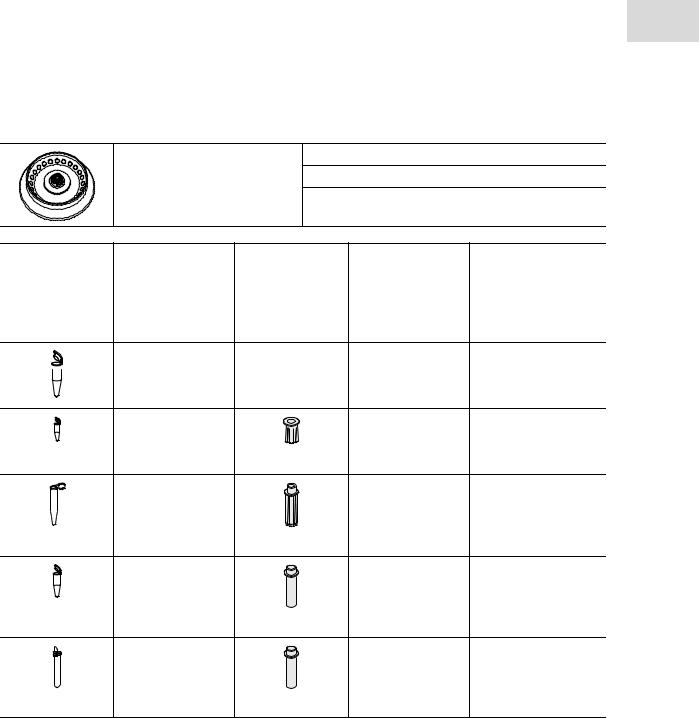
Product description
Centrifuge 5427 R 11
English (EN)
2.4.3Rotor FA-45-24-11-Kit
|
Rotor FA-45-24-11-Kit |
Max. g-force: |
19 090 × g |
|
|
Max. speed: |
13 200 rpm |
||
|
|
|||
|
Aerosol-tight fixed-angle rotor |
|
|
|
|
for 24 tubes |
Max. load (adapter, tube |
24 × 3.75 g |
|
|
|
and contents): |
|
|
Vessels |
Vessel |
Adapters |
Adapter base |
Max. g-force: |
|
Capacity |
Order no. |
Tube diameter |
Max. speed |
|
|
(international) |
|
|
|
Vessels per |
|
|
Centrifugation radius |
|
adapter/rotor |
|
|
|
|
Vessel |
– |
– |
19 090 × g |
|
1.5 mL/2.0 mL |
|
Ø 11 mm |
13 200 rpm |
|
-/24 |
|
|
9.8 cm |
|
PCR tube |
|
conical |
15 000 × g |
|
0.2 mL |
|
Ø 6 mm |
13 200 rpm |
|
1/24 |
5425 715.005 |
|
7.7 cm |
|
Vessel |
|
conical |
19 090 × g |
|
0.4 mL |
|
Ø 6 mm |
13 200 rpm |
|
1/24 |
|
|
9.8 cm |
|
|
5425 717.008 |
|
|
|
Vessel |
|
open |
16 948 × g |
|
0.5 mL |
|
Ø 8 mm |
13 200 rpm |
|
1/24 |
|
|
8.7 cm |
|
|
5425 716.001 |
|
|
|
Microtainers |
|
open |
19 090 × g |
|
0.6 mL |
|
Ø 8 mm |
13 200 rpm |
|
1/24 |
|
|
9.8 cm |
|
|
5425 716.001 |
|
|

Product description
12Centrifuge 5427 R English (EN)
2.4.4 Rotors FA-45-30-11 and F-45-30-11
|
Rotor FA-45-30-11 |
|
Max. g-force: |
20 817 × g |
|
|
Aerosol-tight fixed-angle rotor |
Max. speed: |
14 000 rpm |
||
|
for 30 tubes |
|
|||
|
|
Max. load (adapter, tube |
30 × 3.75 g |
||
|
Rotor F-45-30-11 |
|
|||
|
|
and contents): |
|
||
|
Fixed-angle rotor for 30 tubes |
|
|||
|
|
|
|
||
Vessels |
Vessel |
Adapters |
Adapter base |
Max. g-force: |
|
|
Capacity |
Order no. |
Tube diameter |
Max. speed |
|
|
|
(international) |
|
|
|
|
Vessels per |
|
|
|
Centrifugation radius |
|
adapter/rotor |
|
|
|
|
|
Vessel |
– |
|
– |
20 817 × g |
|
1.5 mL/2.0 mL |
|
|
Ø 11 mm |
14 000 rpm |
|
-/30 |
|
|
|
9.5 cm |
|
PCR tube |
|
|
conical |
16 215 × g |
|
0.2 mL |
|
|
Ø 6 mm |
14 000 rpm |
|
1/30 |
5425 715.005 |
|
7.4 cm |
|
|
Vessel |
|
|
conical |
20 817 × g |
|
0.4 mL |
|
|
Ø 6 mm |
14 000 rpm |
|
1/30 |
|
|
|
9.5 cm |
|
|
5425 717.008 |
|
|
|
|
Vessel |
|
|
open |
18 407 × g |
|
0.5 mL |
|
|
Ø 8 mm |
14 000 rpm |
|
1/30 |
|
|
|
8.4 cm |
|
|
5425 716.001 |
|
|
|
|
Microtainers |
|
|
open |
20 817 × g |
|
0.6 mL |
|
|
Ø 8 mm |
14 000 rpm |
|
1/30 |
|
|
|
9.5 cm |
|
|
5425 716.001 |
|
|
|

Product description
Centrifuge 5427 R 13
English (EN)
2.4.5Rotors FA-45-48-11 and F-45-48-11
|
FA-45-48-11 rotor |
|
Max. g-force: |
18 213 |
× g (outer ring) |
|
|
|
|
|
16 049 |
× g (inner ring) |
|
|
Aerosol-tight fixed-angle rotor |
|
|
|||
|
|
|
|
|
||
|
for 48 tubes |
|
Max. speed: |
12 700 rpm |
||
|
Rotor F-45-48-11 |
|
Max. load (adapter, tube |
48 × 3.75 g |
||
|
Fixed-angle rotor for 48 tubes |
|||||
|
and contents): |
|
|
|||
|
|
|
|
|
||
Vessels |
Vessel |
Adapters |
Adapter base |
Max. g-force: |
||
|
|
|
|
|
Outer ring |
|
|
|
|
|
|
Inner ring |
|
|
Capacity |
Order no. |
Tube diameter |
Max. speed |
||
|
|
(international) |
|
|
|
|
|
Vessels per |
|
|
|
Centrifugation radius |
|
|
adapter/rotor |
|
|
|
Outer ring |
|
|
|
|
|
|
Inner ring |
|
|
Vessel |
– |
|
– |
18 213 |
× g |
|
|
|
|
|
16 049 |
× g |
|
1.5 mL/2.0 mL |
|
|
Ø 11 mm |
12 700 rpm |
|
|
-/48 |
|
|
|
10.1 cm |
|
|
|
|
|
|
8.9 cm |
|
|
PCR tube |
|
|
conical |
14 426 |
× g |
|
|
|
|
|
12 262 |
× g |
|
0.2 mL |
5425 715.005 |
Ø 6 mm |
12 700 rpm |
||
|
|
|
|
|
||
|
1/48 |
|
|
|
8 cm |
|
|
|
|
|
|
6.8 cm |
|
|
Vessel |
|
|
conical |
18 213 |
× g |
|
|
|
|
|
16 049 |
× g |
|
0.4 mL |
|
|
Ø 6 mm |
12 700 rpm |
|
|
1/48 |
5425 717.008 |
|
10.1 cm |
||
|
|
|
|
|
8.9 cm |
|
|
Vessel |
|
|
open |
16 229 |
× g |
|
|
|
|
|
14 065 |
× g |
|
0.5 mL |
|
|
Ø 8 mm |
12 700 rpm |
|
|
1/48 |
5425 716.001 |
|
9 cm |
|
|
|
|
|
|
|
7.8 cm |
|
|
Microtainers |
|
|
open |
18 213 |
× g |
|
|
|
|
|
16 049 |
× g |
|
0.6 mL |
|
|
Ø 8 mm |
12 700 rpm |
|
|
1/48 |
5425 716.001 |
|
10.1 cm |
||
|
|
|
|
|
8.9 cm |
|

Product description
14Centrifuge 5427 R English (EN)
2.4.6 Rotor F-45-48-5-PCR
Rotor F-45-48-5-PCR
Fixed-angle rotor for 48 PCR tubes
Max. g-force: |
11 |
710 × g |
|
|
|
Max. speed: |
10 |
500 rpm |
|
|
|
Max. load (tube and |
48 |
× 0.43 g |
contents): |
|
|
|
|
|
Tubes |
Tube |
Adapter |
Adapter base |
Max. g-force: |
|
Capacity |
|
Tube diameter |
Max. speed |
|
Tubes per adapter/ |
|
|
Centrifugation radius |
|
rotor |
|
|
|
|
|
– |
conical |
11 710 × g |
|
0.2 mL |
|
Ø 6 mm |
10 500 rpm |
|
–/48 |
|
|
9.5 cm |
|
PCR strips |
– |
conical |
11 710 × g |
|
0.2 mL |
|
Ø 6 mm |
10 500 rpm |
|
–/6 × 8 |
|
|
9.5 cm |
2.4.7Rotor S-24-11-AT
This rotor is only intended for use with 1.5 mL/2.0 mL tubes.
The following tubes must not be used in this rotor:
•Adapters for 0.2 mL, 0.4 mL, 0.5 mL and 0.6 mL tubes and the corresponding tubes.
•Spin columns
Rotor S-24-11-AT Bucket for tubes: |
Max. g-force: |
16 049 × g |
4 × 1.5 mL/2.0 mL |
|
|
|
Max. speed: |
12 700 rpm |
|
Max. load per bucket (tube |
4 × 3.75 g |
|
and contents): |
|
Vessels |
Vessel |
Adapters |
Adapter base |
Max. g-force: |
|
Capacity |
Order no. |
Tube diameter |
Max. speed |
|
|
(international) |
|
|
|
Vessels per |
|
|
Centrifugation radius |
|
adapter/rotor |
|
|
|
|
Vessel |
– |
– |
16 049 × g |
|
1.5 mL/2.0 mL |
|
Ø 11 mm |
12 700 rpm |
|
-/24 |
|
|
8.9 cm |

Safety
Centrifuge 5427 R 15
English (EN)
3Safety
3.1Intended use
The Centrifuge 5427 R is intended exclusively for indoor use and for separating aqueous solutions and suspensions of various densities in approved test tubes.
3.2User profile
This device may only be operated by trained specialist staff. They must have carefully read the operating manual and be familiar with the function of the device.
3.3Application limits
3.3.1Declaration concerning the ATEX directive (94/9/EC)
DANGER! Risk of explosion.
Do not operate the device in areas where work is completed with explosive substances.
Do not use this device to process any explosive or highly reactive substances.
Do not use this device to process any substances which may generate an explosive atmosphere.
Due to its design and the environmental conditions inside the device, the Centrifuge 5427 R is not suitable for use in a potentially explosive atmosphere.
The device only must be used in a safe environment, such as the open environment of a ventilated laboratory or fume hood. The use of substances which could create a potentially explosive atmosphere is not permitted. The final decision on the risks associated with the use of these types of substances is the responsibility of the user.
3.3.2Maximum service life for accessories
WARNING! Risk of injury from chemically or mechanically damaged accessories.
Even minor scratches and cracks can lead to serious internal material damage.
Protect all accessory parts from mechanical damage.
Inspect the accessories for damage before each use. Replace any damaged accessories.
Do not use rotors, rotor lids or buckets with signs of corrosion or mechanical damage (e.g., deformations).
Do not use any accessories whose maximum service life has been exceeded.
CAUTION! Risk of injury due to chemically damaged rotor lids or caps.
Transparent rotor lids or caps made from PC, PP or PEI may lose their strength under the impact of organic solvents (e.g., phenol, chloroform).
If rotor lids or caps have come into contact with organic solvents, they should be cleaned immediately.
Regularly check the rotor lids and caps for damages and cracks.
Immediately replace rotor lids or caps that have cracks or milky stains.

Safety
16Centrifuge 5427 R English (EN)
Beginning with the first commissioning, the following rotors including the corresponding buckets, carriers and rotor lids have a maximum service life of 7 years or of the number of cycles specified in the table (depending on what occurs first).
Rotor/accessories |
Maximum service from commissioning onward |
|
|
|
|
S-24-11-AT (5427 R/5430/5430 R) |
75,000 cycles |
7 years |
|
|
|
FA-45-48-11 |
75,000 cycles |
7 years |
(5427 R/5430/5430 R/5804/5804 R/5810/5810 R) |
|
|
|
|
|
FA-45-12-17 (Centrifuge 5427 R) |
75,000 cycles |
7 years |
|
|
|
QuickLock rotor lid |
|
3 years |
|
|
|
Seals of the QuickLock rotor lid |
50 autoclaving cycles |
– |
|
|
|
Rotor lid or caps made of polycarbonate ( PC), |
50 autoclaving cycles |
3 years |
polypropylene (PP) or polyetherimide (PEI) |
|
|
|
|
|
Adapter |
– |
1 year |
|
|
|
For all other rotors and rotor lids of this centrifuge there is no service life limit as long as the following requirements are met:
•Proper use,
•Recommended maintenance
•Undamaged condition
The date of manufacture is stamped on the rotors in the format 03/10 (= March 2010) or on the inside of the plastic rotor lids in the form of a clock  .
.
To ensure aerosol tightness, the following applies:
•Replace aerosol-tight rotor lids and caps after 50 autoclaving cycles.
•Replace the seal of QuickLock rotor lids after 50 autoclaving cycles.
3.4Information on product liability
In the following cases, the designated protection of the device may be compromised. Liability for any resulting property damage or personal injury is then transferred to the operator:
•The device is not used in accordance with the operating manual.
•The device is used outside of its intended use.
•The device is used with accessories or consumables which are not recommended by Eppendorf.
•The device is maintained or repaired by people not authorized by Eppendorf.
•The user makes unauthorized changes to the device.

Safety
Centrifuge 5427 R 17
English (EN)
3.5Warnings for intended use
Read the operating manual and observe the following general safety instructions before using the Centrifuge 5427 R.
3.5.1Personal injury or damage to the equipment
WARNING! Electric shock due to damage to device or mains cable.
Only switch on the device if the device and mains cable are undamaged.
Only use devices that have been properly installed or repaired.
In case of danger, disconnect the device from the mains supply by pulling the power plug from the device or the mains socket or, by using the isolating device intended for this purpose (e.g. emergency stop switch in the laboratory).
WARNING! Lethal voltages inside the device.
Ensure that the housing is always closed and undamaged so that no parts inside the device can be contacted by accident.
Do not remove the housing of the device.
Do not allow any liquids to penetrate the inside of the housing.
Do not allow the device to be opened by anyone except service personnel who have been specifically authorized by Eppendorf.
WARNING! Risk from incorrect supply voltage
Only connect the device to voltage sources which correspond to the electrical requirements on the name plate.
Only use sockets with a protective earth (PE) conductor and suitable power cable.
WARNING! Damage to health due to infectious liquids and pathogenic germs.
When handling infectious liquids and pathogenic germs, observe the national regulations, the biological security level of your laboratory, the material safety data sheets, and the manufacturer's application notes.
Use aerosol tight sealing systems for the centrifugation of these substances.
When working with pathogenic germs belonging to a higher risk group, more than one aerosol-tight bioseal must be used.
Wear personal protective equipment.
For full instructions regarding the handling of germs or biological material of risk group II or higher, please refer to the "Laboratory Biosafety Manual" (Source: World Health Organization, current edition of the Laboratory Biosafety Manual).
WARNING! Risk of injury when opening or closing the centrifuge lid.
There is a risk of crushing your fingers when opening or closing the centrifuge lid.
When opening or closing the centrifuge lid, do not reach between the lid and device or into the latching mechanism of the lid.
Always open the centrifuge lid completely to prevent it from falling.
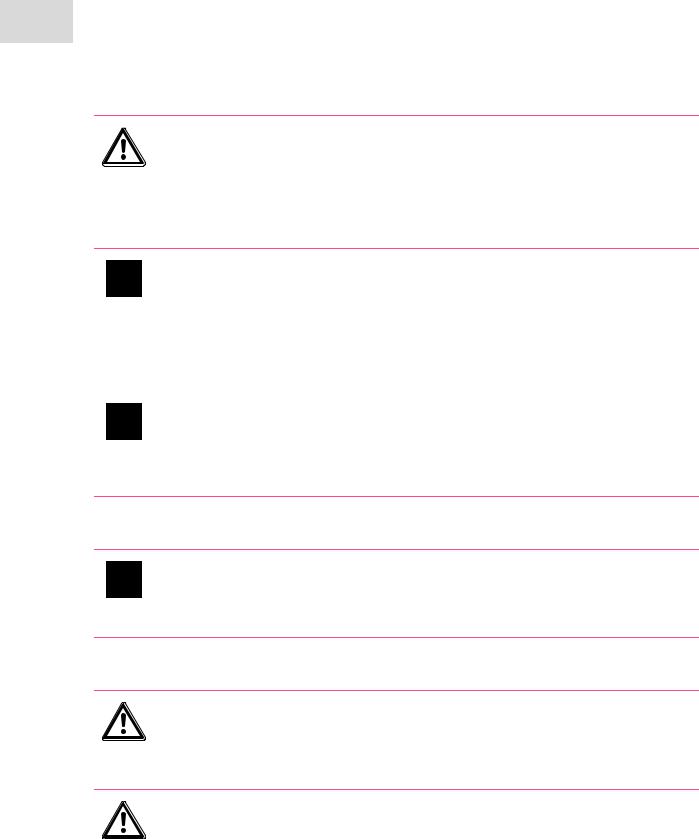
Safety
18Centrifuge 5427 R English (EN)
CAUTION! Poor safety due to incorrect accessories and spare parts.
The use of accessories and spare parts other than those recommended by Eppendorf may impair the safety, functioning and precision of the device. Eppendorf cannot be held liable or accept any liability for damage resulting from the use of incorrect or non-recommended accessories and spare parts, or from the improper use of such equipment.
Only use accessories and original spare parts recommended by Eppendorf.
NOTICE! Damage to device due to spilled liquids.
1.Switch off the device.
2.Disconnect the device from the power supply.
3.Carefully clean the device and the accessories in accordance with the cleaning and disinfection instructions in the operating manual.
4.If a different cleaning and disinfecting method is to be used, contact Eppendorf AG to ensure that the intended method will not damage the device.
NOTICE! Damage to electronic components due to condensation.
Condensate can form in the device after it has been moved from a cool environment to a warmer environment.
After installing the device, wait for at least 4 h. Only then connect the device to the mains power supply.
3.5.2Incorrect handling of the centrifuge
NOTICE! Damage from knocking against or moving the device during operation.
If the rotor bangs against the rotor chamber wall, it will cause considerable damage to the device and rotor.
Do not move or knock against the device during operation.
3.5.3Incorrect handling of the rotors
WARNING! Risk of injury from improperly attached rotors and rotor lids.
Only centrifuge with rotor and rotor lid firmly tightened.
If unusual noises occur when the centrifuge starts, the rotor or the rotor lid may not be properly secured. Immediately press the start/stop key to stop centrifuging.
CAUTION! Risk of injury due to asymmetric loading of a rotor.
Load rotors symmetrically with identical tubes.
Only load adapters with suitable tubes.
Always use the same type of tubes (weight, material/density and volume).
Check symmetric loading by balancing the adapters and tubes used with scales.

Safety
Centrifuge 5427 R 19
English (EN)
CAUTION! Risk of injury from overloaded rotor.
The Centrifuge 5427 R is designed for the centrifugation of material with a max. density of 1.2 g/mL at maximum speed and filling volume and/or load.
Do not exceed the maximum load of the rotor.
NOTICE! Damage to rotors from aggressive chemicals.
Rotors are high-quality components which withstand extreme stresses. This stability can be impaired by aggressive chemicals.
Avoid using aggressive chemicals, including strong and weak alkalis, strong acids, solutions with mercury, copper and other heavy metal ions, halogenated hydrocarbons, concentrated saline solutions and phenol.
Due to the manufacturing process, color variations may occur on rotors marked "coated". These color variations do not effect service life or resistance to chemicals.
NOTICE! If handled incorrectly, the rotor can fall over.
The rotor can fall over if the buckets are used as a handle.
Remove the buckets before inserting and/or removing a swing-bucket rotor.
Always use both hands to carry the rotor cross.
3.5.4Extreme strain on the centrifuging tubes
CAUTION! Risk of injury from overloaded tubes.
Note the loading limits specified by the tube manufacturer.
Only use tubes which are approved by the manufacturer for the required rcf.
NOTICE! Risk from damaged tubes.
Damaged tubes must not be used, as this could cause further damage to the device and the accessories and loss of the samples.
Before use, visually check all of the tubes for damage.
NOTICE! Risk from open tube lids.
Open tube lids can brake off during centrifugation and damage the rotor and the centrifuge.
Carefully seal all tube lids before centrifuging.
Exception: Note the information on the centrifugation of spin columns in the rotor FA-45-24-11-Kit (see Preparing for centrifugation on p. 27).
NOTICE! Hazard to plastic tubes from organic solvents.
The density of plastic tubes is reduced when organic solvents (e.g., phenol, chloroform) are used, i.e. the tubes could become damaged.
Observe the manufacturer's specifications for chemical resistance of the tubes.
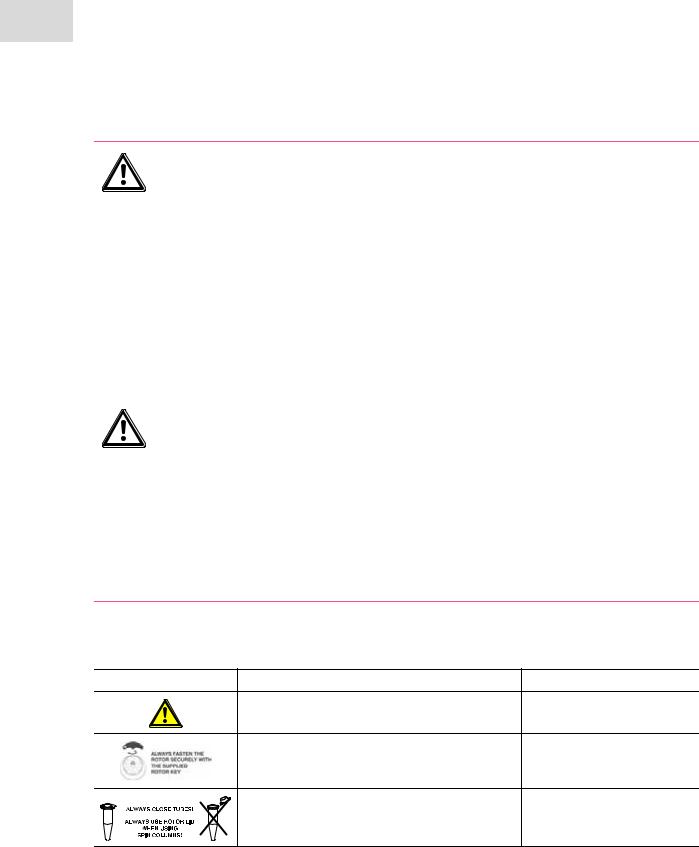
Safety
20Centrifuge 5427 R English (EN)
3.5.5 Aerosol-tight centrifugation
WARNING! Risk to health due to limited aerosol tightness with incorrect rotor/rotor lid combination.
Aerosol-tight centrifugation is guaranteed only if the rotors and rotor lids intended for this purpose are used. The designation of aerosol-tight fixed-angle rotors always starts with FA.The aerosol-tight rotors and rotor lids of this centrifuge are additionally marked with a red ring on the rotor and a red rotor lid screw.
Aerosol-tight swing-bucket rotors are marked with AT (aerosol-tight).
For aerosol-tight centrifugation, always simultaneously use rotors and rotor lids which are marked as aerosol-tight in the centrifuge intended for the corresponding purpose. The details specifying in which centrifuge you may use the aerosol-tight rotors and rotor lids can be found on the rotor and, beginning from production date of October 2003, on the upper side of the rotor lid.
Only use aerosol-tight rotor lids in combination with rotors which are marked on the rotor lid.
WARNING! Damage to health as a result of limited aerosol tightness and incorrect usage.
Autoclaving, mechanical stresses and contamination by chemicals or other aggressive solvents can impair the aerosol-tightness of the rotors and rotor lids.
Check the integrity of the seals of the aerosol-tight rotor lids or caps before each use.
Only use aerosol-tight rotor lids or caps if the seals are undamaged and clean.
Lightly grease the threads of the rotor lid screw with pivot grease after every proper autoclaving (121 °C, 20 min.) (int. order no. Int. 5810 350.050, North America 022634330).
Replace aerosol-tight rotor lids and caps after 50autoclaving cycles.
For QuickLock rotor lids, the seal must be replaced after 50 autoclaving cycles.
Never store aerosol-tight rotors or buckets closed.
3.6Safety instructions located on the device
Display |
Meaning |
Location |
|
Hazard point |
Right side of the device |
|
CAUTION |
Top of device, below the |
|
Always tighten the rotor using the supplied rotor |
centrifuge lid |
|
key. |
|
|
CAUTION |
Top of device, below the |
|
Close all tubes and use a rotor lid. |
centrifuge lid |

Installation
Centrifuge 5427 R 21
English (EN)
4Installation
4.1Selecting the location
NOTICE! If an error occurs, the objects in the immediate proximity of the device will be damaged.
In accordance with recommendations in EN 61010-2-020, leave a safety clearance of 30 cm around the device during operation.
Please remove all materials and objects from this area.
NOTICE! Damage from overheating.
Do not install the device near heat sources (e.g. heating, drying cabinet).
Do not expose the device to direct sunlight.
Ensure unobstructed air circulation. Maintain a clearance of at least 30 cm (11.8 in) around all ventilation grilles.
Select the location for the device according to the following criteria:
•Suitable power connection as per the name plate (230 V/120 V/100 V).
•Stable, horizontal and resonance-free lab bench.
•A well ventilated environment which is protected from direct sunlight to prevent the device from heating up more.
4.2Preparing installation
Prerequisites
The weight of the centrifuge is 30.0 kg (66.14 lb). For unpacking and installation the assistance of another person is required.
Perform the following steps in the sequence described.
1.Open the box.
2.Remove the accessories.
3.The centrifuge must be lifted from the box by two people.
4.Remove the transport securing device from the sides.
5.Place the device on a suitable lab bench.
Do not use the opening for the condensation water tray as a handle.
6. Remove the plastic sleeve.

Installation
22Centrifuge 5427 R English (EN)
4.3Installing the instrument
Prerequisites
The device is on a suitable lab bench.
NOTICE! Damage to electronic components due to condensation.
Condensate can form in the device after it has been moved from a cool environment to a warmer environment.
After installing the device, wait for at least 4 h. Only then connect the device to the mains power supply.
NOTICE! Centrifuge 5427 R: compressor damage after improper transport.
Only switch on the centrifuge 4 h after installation.
Perform the following steps in the sequence described.
1.Let the device warm up to ambient temperature.
2.Check that the mains voltage and frequency match the requirements on the device type plate.
3.Connect the centrifuge to the mains and switch it on using the mains/power switch.
•Display is active.
•Lid opens automatically
4.Remove the transport securing device of the lid latch.
5.Remove the transport securing device of the motor shaft.
6.Use the details included in the scope of delivery to check that the delivery is complete.
7.Check all parts for any transport damage. Contact your dealer if any damage is found.
8.Insert the condensation water tray into the holder provided (see Fig. 2-1 on p. 7).
Retain the packaging material and the transport protection device for subsequent transport or storage. See also the instructions relating to transport (see p. 45).
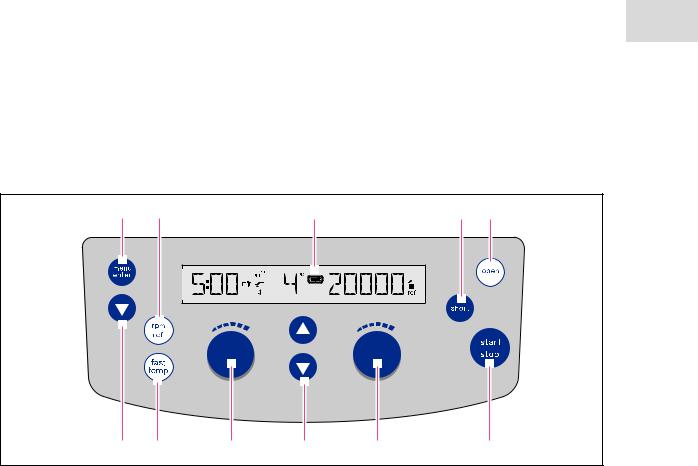
Operation
Centrifuge 5427 R 23
English (EN)
5Operation
5.1Overview of operating controls
Before using the Centrifuge 5427 R, familiarize yourself with the display and operating controls.
1 |
2 |
3 |
4 |
5 |
|
time |
temp |
speed |
|
10 |
10 |
9 |
8 |
7 |
6 |
Fig. 5-1: Operator panel of the Centrifuge 5427 R
1 |
Call and select the menu parameters |
7 |
Set speed of centrifugation |
|
(see Menu navigation on p. 25) |
8 |
Set temperature |
|
|
||
2 |
Switch display of centrifugation speed (rpm or |
9 |
Set centrifugation time |
|
rcf) |
|
|
3 |
Display |
10 |
Start FastTemp temperature control run |
|
(see Start FastTemp on p. 31) |
||
|
|
|
|
4 |
Short spin centrifugation |
11 |
Select menu item |
|
(see Short spin centrifugation on p. 34) |
||
|
|
(see Menu navigation on p. 25) |
|
|
|
|
|
5 |
Release lid |
|
|
6 |
Start and stop centrifugation |
|
|
Please also read the precise description of the individual menu functions (see p. 25).

Operation
24Centrifuge 5427 R English (EN)
1 |
2 |
3 |
4 |
5 |
6 |
7 |
|
|
|
|
9 |
8 |
Fig. 5-2: Display of the Centrifuge 5427 R.
1 Centrifugation time
2Key lock
 Key lock. Centrifugation parameters cannot be accidentally changed.
Key lock. Centrifugation parameters cannot be accidentally changed.
 No key lock. Centrifugation parameters can be changed.
No key lock. Centrifugation parameters can be changed.
3Start of run time: ATSET function
 Start of run time after reaching 95 % of the specified g-force (rcf) or speed (rpm).
Start of run time after reaching 95 % of the specified g-force (rcf) or speed (rpm).
 Immediate start of run time.
Immediate start of run time.
4 Temperature
5Soft ramp


 Rotor accelerates and brakes slowly.
Rotor accelerates and brakes slowly.
No symbol: fast acceleration and braking of rotor.
6g-force (rcf) or speed (rpm)
(see Rotors on p. 9)
7Status of centrifuge
 : Centrifuge lid unlocked.
: Centrifuge lid unlocked.
 : Centrifuge lid locked.
: Centrifuge lid locked.
 (Flashing): Centrifuging in progress.
(Flashing): Centrifuging in progress.
8Display of centrifugation speed
rcf g-force (relative centrifugal acceleration). rpm speed (revolutions per minute).
9 Status of speaker
 Speaker switched on.
Speaker switched on. 
 Speaker switched off.
Speaker switched off.
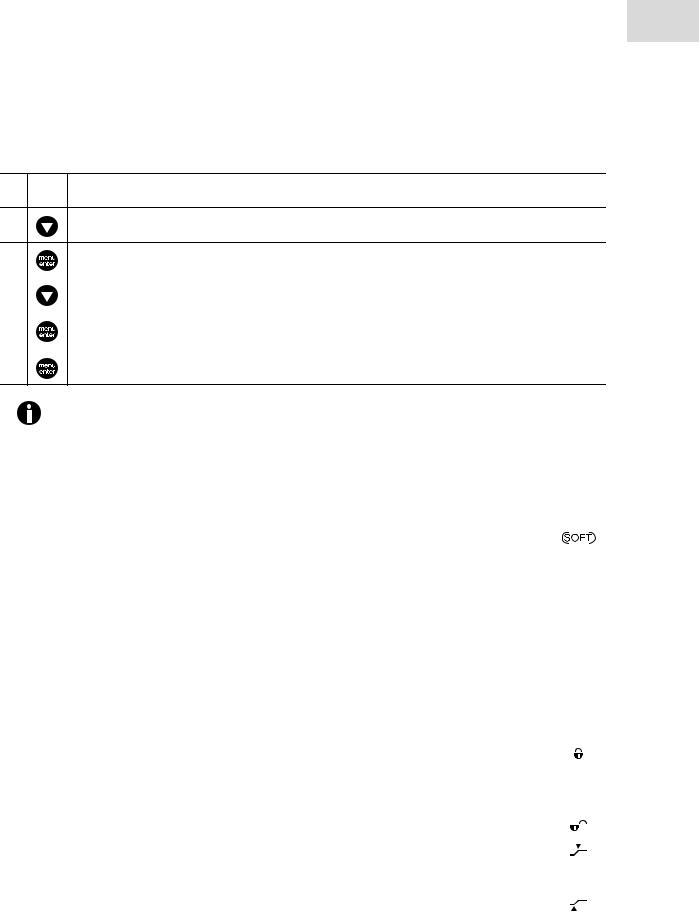
Operation
Centrifuge 5427 R 25
English (EN)
5.2Menu navigation
Proceed as follows to change settings in the device menu:
1. Open the menu.
Open the menu.
2. Select the desired menu item.
3. |
Confirm your selection. |
|
|
|
|
4. |
Select the setting of the corresponding parameters. |
|
|
|
|
5. |
Confirm the changed setting. |
|
The BACK menu item belonging to the first menu level appears. |
||
|
||
|
|
|
6. |
Exit the menu. |
To exit the second menu level without changing a parameter, select the BACK menu item and confirm with menu/enter.
5.3Menu
Tab. 5-1: Menu structure of the Centrifuge 5427 R.
Menu level 1 (M 1) |
Menu level 2 (M 2) |
|
Display |
|||
|
|
|
|
|
|
|
SOFT |
On |
Rotor accelerates and brakes slowly. |
|
|
|
|
|
|
|
||||
Soft ramp: decreases acceleration speed |
OFF |
Rotor accelerates and brakes rapidly. |
|
|
|
|
|
|
|
||||
and braking speed |
|
|
|
|||
|
|
|
|
|
|
|
Disabled with short spin centrifugation |
|
|
|
|
|
|
|
|
|
|
|
|
|
RAD |
0_2ML |
Select the radius according to the adapter |
|
|
|
|
For the internal conversion of speed (rpm) |
0_4ML |
used. |
|
|
|
|
to g-force (rcf), the radius is dependent on |
0_5ML |
Only rotor FA-45-12-17: |
|
|
|
|
the adapter used. |
0_6ML |
MAX |
|
|
|
|
|
|
1_5/2 |
|
|
|
|
|
|
HPLC |
|
|
|
|
|
|
CRYO |
|
|
|
|
|
MAX |
Largest radius of the used rotor. |
|
|
|
|
|
|
|
|
|
|
|
LOCK |
On |
Set the centrifugation parameters |
|
|
|
|
Key lock: centrifugation parameters |
|
permanently. SAFE appears in the display |
|
|
|
|
(temperature, g-force (rcf) or speed (rpm)) |
|
when the time, temp or speed keys are |
|
|
|
|
cannot be accidentally changed. |
|
pressed. |
|
|
|
|
|
OFF |
|
|
|
|
|
|
|
|
|
|
|
|
ATSET |
On |
The set run time will be counted down |
|
|
|
|
Set start of centrifuging run time. |
|
after 95 % of the specified |
g-force (rcf) or |
|
|
|
|
|
speed (rpm) has been reached. |
|
|
|
|
|
OFF |
The set time is counted down immediately. |
|
|
|
|
|
|
|
|
|
|
|

Operation
26Centrifuge 5427 R English (EN)
Menu level 1 (M 1) |
Menu level 2 (M 2) |
|
Display |
|
|
|
|
|
|
SHORT |
MAX |
Short spin centrifugation at the maximum |
|
|
Set the speed of the short spin |
|
speed of the inserted rotor |
|
|
centrifugation. |
Set |
Short spin centrifugation with set speed |
|
|
No SOFT function with short spin |
|
|||
|
(g-force (rcf) or speed |
(rpm)). |
|
|
centrifugation. |
|
|
||
|
|
|
|
|
|
|
|
|
|
Temp |
8 h |
Default setting: Continuous cooling ends |
|
|
Set the time limit for continuous cooling |
|
after 8 h. |
|
|
("ECO shut-off") (see p. 30). |
1 h |
To limit continuous cooling after a run to |
|
|
|
|
|||
|
2 h |
1 h, 2 h, or 4 h, the centrifuge lid must be |
|
|
|
4 h |
opened and closed again after the run. |
|
|
|
oo |
Endless operation of continuous cooling. |
|
|
|
|
|
|
|
Alarm |
On |
Switch on loudspeaker. |
|
|
Switch the loudspeaker on or off. |
OFF |
Switch off loudspeaker. |
|
|
|
|
|||
|
|
|
|
|
VOL |
VOL1 |
The volume of the loudspeaker can be set |
|
|
Set the volume. |
… |
to 5 levels (VOL1 to VOL5). The |
|
|
|
VOL5 |
loudspeaker must be switched on for the |
|
|
|
|
adjustment to be audible. |
|
|
|
|
|
|
|
SLEEP |
On |
Standby mode activated. |
|
|
Switch the standby mode on or off. |
OFF |
Standby mode deactivated. |
|
|
If the centrifuge has not been used for |
|
|||
|
|
|
|
|
15 min, it will switch to standby. EP then |
|
|
|
|
appears in the display. |
|
|
|
|
Press a key or close the centrifuge lid to |
|
|
|
|
exit the standby mode. |
|
|
|
|
|
|
|
|
|
The Back menu item can also be found in both menu levels.
Back in menu level 2: return to menu level 1.
Back in menu level 1: exit menu.

Operation
Centrifuge 5427 R 27
English (EN)
5.4Preparing for centrifugation
5.4.1 Switching on the centrifuge
Switch the centrifuge on using the mains/power switch.
The centrifuge lid opens automatically after switching on using the mains/power switch. The parameter settings of the last run are displayed.
5.4.2 Inserting the rotor
1.Fit the rotor vertically on the motor shaft.
2.Insert the supplied rotor key into the rotor nut.
3.Turn rotor key clockwise until the rotor nut is firmly tightened.
5.4.3Automatic rotor detection
The centrifuge has automatic rotor detection. It detects a newly inserted rotor and displays the name of the rotor for 2 s. g-force (rcf) and speed (rpm) are automatically limited to the maximum permitted value for the rotor.
Manually turn the rotor counterclockwise to trigger rotor detection.
•The name of the rotor appears in the display.
•The g-force (rcf) and speed (rpm) are automatically limited to the maximum permissible value for the rotor.
5.4.4Replacing the rotor
1.Turn the rotor nut counterclockwise using the supplied rotor key.
2.Remove the rotor by lifting it vertically.
3.Vertically place another rotor on the motor shaft.
4.Insert the supplied rotor key into the rotor nut.
5.Turn rotor key clockwise until the rotor nut is firmly tightened.
6.In order to trigger the rotor detection, turn the rotor counterclockwise by hand.
•The name of the rotor appears in the display.
•The g-force (rcf) and speed (rpm) are automatically limited to the maximum permissible value for the rotor.
Rotor detection can also be triggered by short spin centrifugation:
Press the short key until the name of the rotor appears in the display.
Error message after rotor change
• If you start centrifuging immediately after a rotor change, the centrifuge has not carried out an automatic rotor detection yet. The speed set for the previous rotor may exceed the maximum permitted speed for the new rotor. In this case, the centrifuge stops after the automatic rotor detection and displays SPEED. The new maximum permitted speed appears in the display. You can then restart the centrifuging with this setting or adjust the speed as necessary.
After each rotor change, check whether the new rotor is detected by the device. Check the set g-force (rcf) or speed (rpm) and adjust it if necessary.
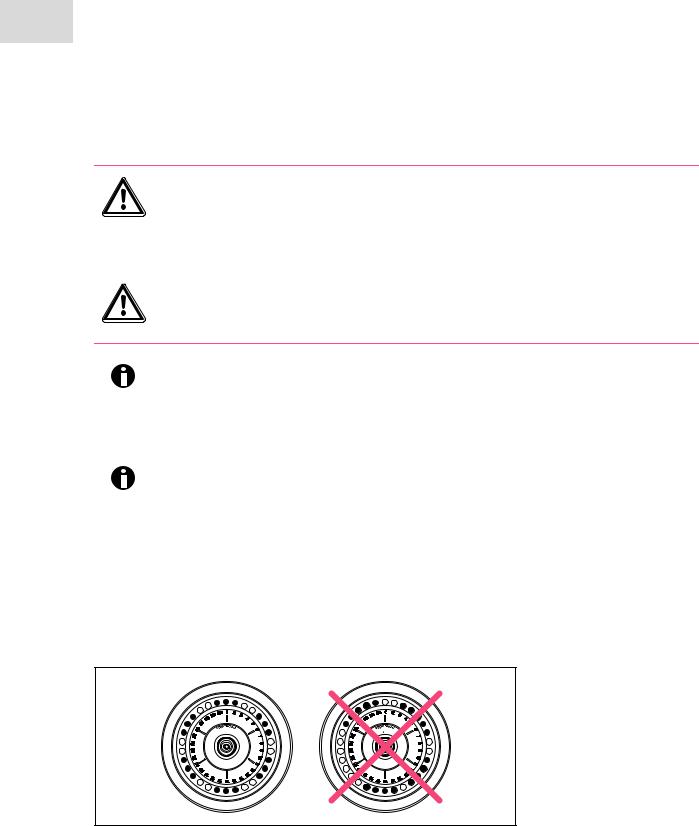
Operation
28Centrifuge 5427 R English (EN)
5.4.5Loading the rotor
5.4.5.1 Loading a fixed-angle rotor
CAUTION! Risk of injury due to asymmetric loading of a rotor.
Load rotors symmetrically with identical tubes.
Only load adapters with suitable tubes.
Always use the same type of tubes (weight, material/density and volume).
Check symmetric loading by balancing the adapters and tubes used with scales.
CAUTION! Risk from damaged or overloaded tubes.
When loading the rotor, observe the safety precautions on dangers as a result of overloaded or damaged tubes (see Warnings for intended use on p. 17).
Use matching rotor lids
• Fixed-angle rotors may only be operated with the appropriate rotor lid in each case. The rotor name on the rotor must be the same as the name on the rotor lid.
•To carry out an aerosol-tight centrifugation, an aerosol-tight rotor (label: red ring) and the corresponding aerosol-tight rotor lid (label: aerosol-tight and red lid screw) must be used.
The device automatically detects imbalances during operation and stops the run immediately with an error message and a signal tone.
Check the load, balance the tubes and restart the run.
To load the rotor, proceed as follows:
1.Check the maximum payload (adapter, tube and contents) for each rotor bore.
The information about this can be found on every rotor and in this operating manual (see Rotors on p. 9).
2.Load rotors and adapters only with the tubes intended for them.
3.Insert sets of two tubes in the opposite bores of the rotor. To ensure symmetric loading, tubes that are arranged opposite each other must be of the same type and contain the same filling quantity.
To minimize weight differences between filled sample tubes, we recommend taring with a scale. This will reduce wear on the drive and reduce running noise.
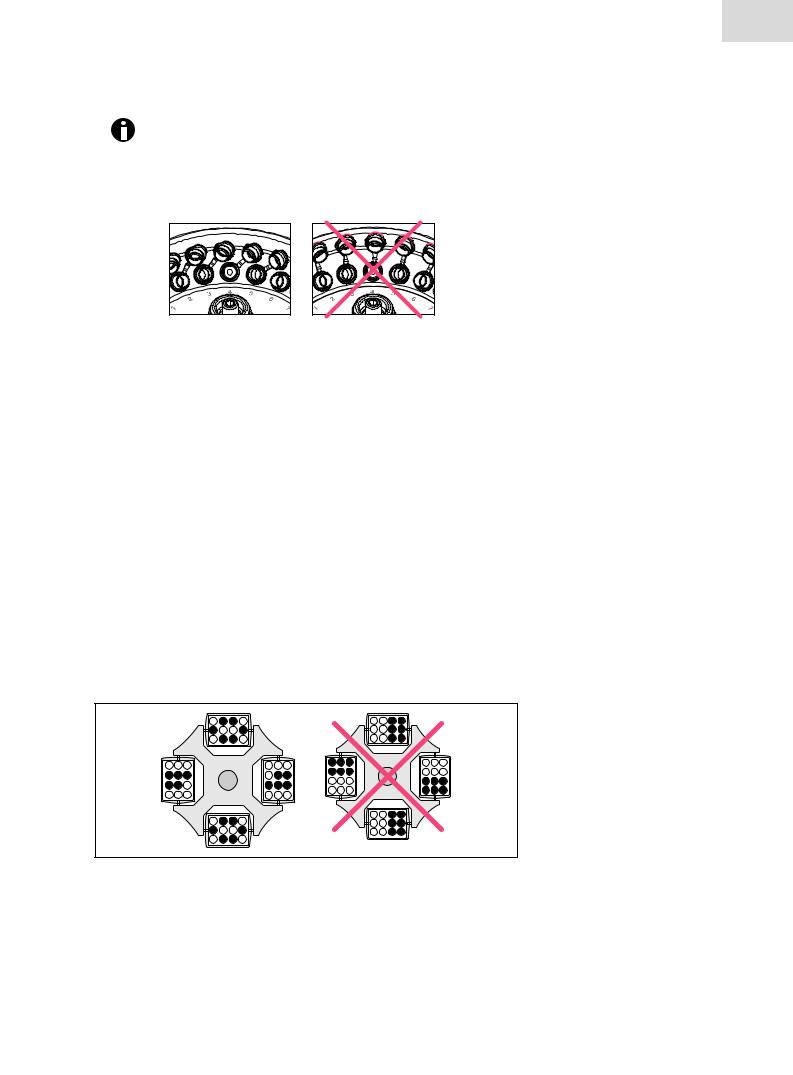
Operation
Centrifuge 5427 R 29
English (EN)
Spin columns
For centrifuging spin columns in the rotor FA-45-24-11-Kit, you can leave the tube lids open. However, this can only be done using the tubes provided by kit manufacturers for this purpose. For reliable centrifugation, you must lean the open tube lids against the edge of the rotor. Ensure that the lids do not protrude past the edge of the rotor in the process, then attach the matching rotor lid.
5.4.5.2 Loading a swing-bucket rotor
Prerequisites
•Use a rotor, bucket and adapter combination that is approved by Eppendorf.
•The carriers are sorted by weight category. Carriers located opposite each other must belong to the same weight category. This is laterally engraved in the groove: e.g., 68 (the last two digits in grams). For repeat orders, please specify the weight class.
•Matched and checked tubes
To load the rotor, proceed as follows:
1.Check the bucket grooves for cleanliness and lightly lubricate them with pivot grease (int. order no.: 5810 350.050 / North America: 022634330).
Contaminated grooves and pegs prevent a uniform swinging of the bucket.
2.Hang the buckets into the rotor.
All rotor positions must be loaded with carriers.
3.Check that all carriers are hanging properly and can swing freely.
4.Check the maximum payload (adapter, tube and contents) for each bucket.
The details on the maximum payload can be found on the rotor and in this operating manual (see Rotors on p. 9).
5.Load the buckets symmetrically.
Fig. 5-3: Incomplete, but symmetric loading of the buckets. The pegs of each bucket must be uniformly loaded.
The supply shown on the right side is incorrect because it does not allow the bucket to properly swing out.
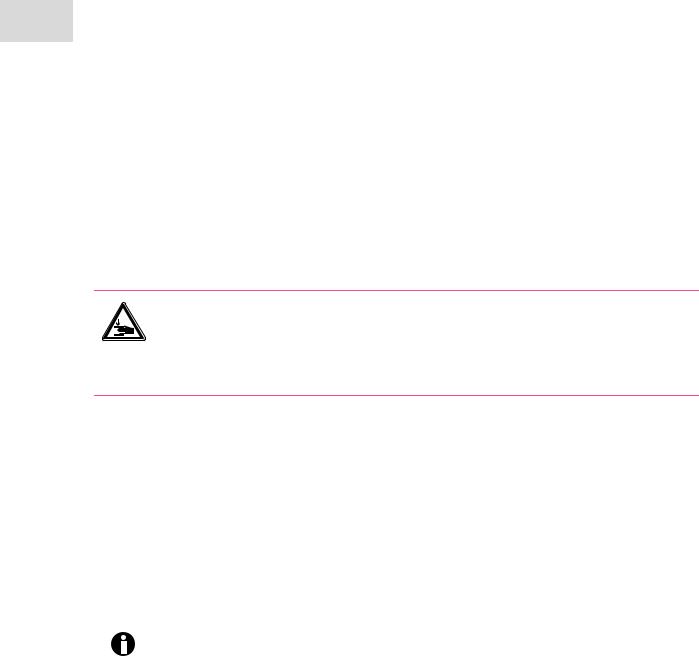
Operation
30Centrifuge 5427 R English (EN)
5.4.6 Closing the rotor lid
1.Only QuickLock rotor lid: check that the external sealing ring correctly fits in the groove.
2.Vertically fit the rotor lid on the rotor.
3.Turn the rotor lid screw clockwise to seal the rotor.
Only QuickLock rotor lid:
Turn the rotor lid screw clockwise as far as it will go, until an audible "click" can be heard. The rotor is not properly closed until an audible click is heard!
5.4.7Closing the centrifuge lid
WARNING! Risk of injury when opening or closing the centrifuge lid.
There is a risk of crushing your fingers when opening or closing the centrifuge lid.
When opening or closing the centrifuge lid, do not reach between the lid and device or into the latching mechanism of the lid.
Always open the centrifuge lid completely to prevent it from falling.
1.Check the correct attachment of the rotor and rotor lid.
2.Press the centrifuge lid down until it is gripped by the lid latch.
The lid will be automatically closed and the locking mechanism can be clearly heard.
The open key lights up blue. The display shows the  symbol.
symbol.
5.5Cooling
The centrifuge cools or maintains the set temperature is the following requirements are met:
•The centrifuge is switched on.
•The centrifuge lid is closed.
•Only with continuous cooling: The set temperature is lower than the ambient temperature.
If the rotor stops (continuous cooling), cooling is slower than during centrifugation or a temperature control run.
5.5.1 |
Set the temperature |
|
|
1. |
To set the temperature, use the temp arrow keys to select a temperature between -11 °C and 40 °C. |
||
2. |
Set the run time and g-force (rcf) or speed (rpm). Press the start/stop key to start the centrifugation. |
||
The temperature can be changed during centrifugation. |
|||
5.5.2 |
Temperature display |
|
|
Temperature display if the rotor stops |
Set temperature |
||
Temperature display during centrifugation |
Actual temperature |
||
